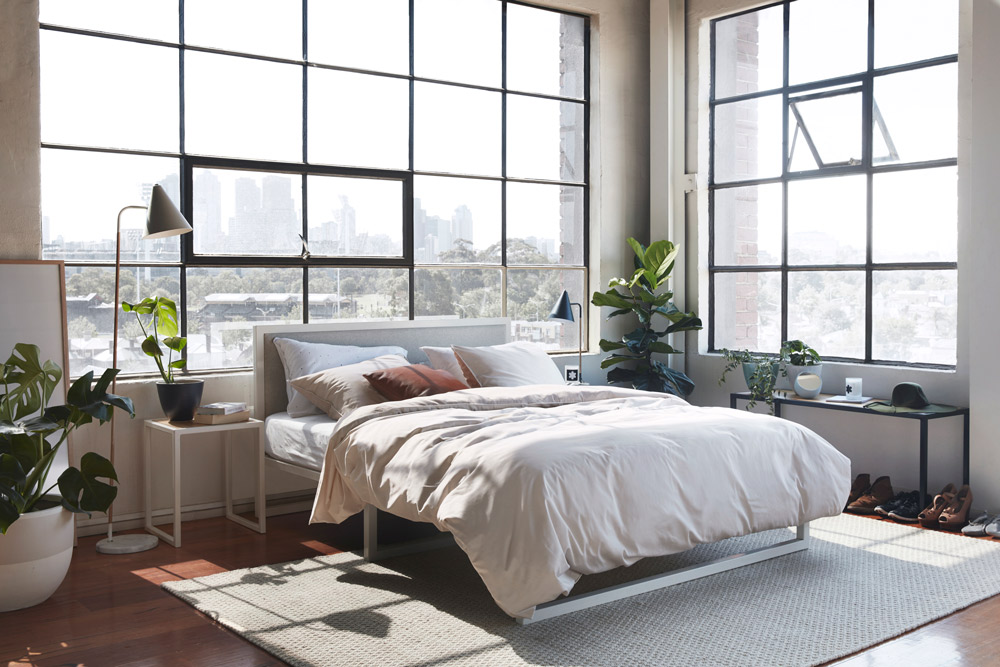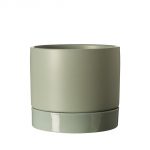You’ve probably seen that we love our greenery here at Hunting for George. We have indoor plants all throughout our Showroom, Office and even warehouse. And in my home, you will not enter a single room without spotting a plant or two or let’s face it five. I wouldn’t call myself an expert however I have learnt quite a few tips along the way thanks to greenery rockstars Rocky and Naomi! However 5 years ago, I was a serial plant killer. I seemed to have the hand/watering can of death. Those were sad times. So if you are struggling to look after your plants there is still hope you yet. Today, I thought we’d chat about the basics on how to start your own indoor garden and share a few tips that I’ve learnt along the way.
1. Start Small
If indoor plants are new to you then perhaps hold off from buying that 2 metre tall fiddle leaf fig tree and instead choose a more manageable plant. The size does not necessarily dictate if a plant will be easy to manage, however I’d still suggest starting small to get a feel for it and once your confidence grows then bring in larger plants and trees.

2. Choose “Hard to Kill” plants
Regardless of whether you’re a novice or a pro, it does help to introduce some hardy indoor plants into your space. After all life can get pretty busy sometimes and it is helpful to have some low maintenance plants to take care of. Here are some great “hard to kill” plants:

Snake Plant, also known as Mother-in-Law’s Tongue. This has thick, tough, waxy leaves. He is very happy in a pot and also very content to be ignored. We have a Snake Plant in our office that gets ignored a lot but he is thriving! We give him the odd watering when we remember and he is in a position that receives natural light.

Aloe Vera, known for its plump and spiky leaves this guy doesn’t need too much watering. You want to make sure the soil drys out before watering again so you could be watering around every 2-3 weeks. And the great thing about Aloe Vera is that you can also snap off the leaf and use its aloe vera gel which has wonderful healing properties, great for cuts or styes.

Devil’s Ivy, this is a favourite for many and personally I love the look of the Devil’s Ivy! It has beautiful lush heart shaped leaves and it grows and grows and grows!! It makes a great choice for a hanging plant and it can handle any light condition you through at it. We have Devil’s Ivy in our studio living in both high and low light conditions, and all of them are doing well (the ones in high light conditions just need a touch more water as the soil drys out faster).

Rubber Plant, or Ficus Elastica Robusta. The Rubber Plant is a winner and is great if you want to have a larger plant that is still low maintenance. The leaves of the Rubber plant can vary from deep green to a rich burgundy colour. Make sure the soil has dried out before watering.
3. Find the perfect spot
Selecting the location for your indoor plants can make or break your gardening goals. Regardless of how much TLC you provide if you can’t give your plant babe sunlight, he’s a goner! So make sure you consider this. If you have a room that receives light but not a lot of it, make sure you select indoor plants that can handle low light conditions. A Snake Plant or a Devil’s Ivy would be a good choice. How do you know if your plant is happy in his position? He’ll tell you. Trust me! If its leaves start to droop, fall off or discolour first check to see if it needs water. If not, it may just be that he’s not happy with the amount of light he is getting. So move him, he may need more or less light. Every plant is a little different. Trial and error. Just be sure to respond quickly if your plant starts to get a bit sad.
4. A Little Afternoon Spritz
Whilst every plant requires different amounts of watering I have never come across an indoor plant that doesn’t love a good spritz. This is a great thing to do if you’re not quite sure if your plant needs another watering, but you still want to give him a little pick me up. I love spritzing my face with water as its so refreshing and it is just the same for plants. When you’re spritzing, if you notice any leaves that are particularly dusty then be sure to wipe them down gently. If there is dust or dirt coating the leaf it will struggle to breathe.

5. Nurture them
Plants are like people and they are all a little different. The trick to treating them right is to try and mimic the climate of the place the plant came from (so if you’re trying desperately to grow a Tropical climate plant in Tasmania and it’s not working, that could be the reason). If you’re not sure what the origins of your plant are do some research to work out your best approach. Here are some books that we love to turn too when we need some more advice or ideas…

Now the Fun Part: Styling!
While most plants are sold in a standard plastic pot, we love to style up our plants so they look extra special in our home. I love to do use a Uashmama Paper Bag and Ceramic Planters for small plants and of course I can’t go past our Buddy Pot for Large Plants. I rely a lot on drip trays, which are very cheap and you can buy from any garden supply shop. You will want to choose a drip tray that is the correct size for your plant (and that will fit inside your chosen pot). Alternatively you can opt to pot your plant directly into a pot, just be sure to check whether or not the pot has a drainage hole. If yes, and you would like to use indoors then you need to remember to get a saucer so that the water does not leak onto your floor. Personally though I prefer to keep my plants in their own plastic pot and use a drip tray within the pot of my choice.
Hot tip! A drip tray is also helpful to let you know how much water your plant has absorbed. As any excess water will drain into the drip tray. Little to no plants like to be submerged in water, so if you find that your drip tray is full of water, take it outside so that you can tip it out. If your plant is really really dry and needs water, it may struggle to absorb the water. If this happens you can leave it submerged in water for an hour or so, but if it is still submerged after that it would be best to tip out the water and just keep a closer eye on it. Try spritzing it too, this will help to hydrate gradually.
When choosing which pot or vessel is right for you, be sure to measure the diameter of your pot plant. As that will dictate the size that you need. All our Garden & Outdoor Pots and Planters have their dimensions listed online. Here are some of our favourites:
And last but not least I recommend chatting to your plants. Yes, yes I know I am a Crazy Plant Lady but I think that it helps to have little conversations with your plants when you’re giving them a water! Perhaps it doesn’t do much for the plants but it sure helps me to look after them better because they become part of the family. And don’t forget I used to be a plant murderer so every little bit helps. I do hope that you have found this helpful and I very much encourage you to bring plants into your home. It will make you happy 100% guaranteed and your home will look amazing. Happy planting!



























